|
ARBOR ARES-1230/1230-E/1231
Sometimes you need a lot (or a whole lot) of I/O in a fanless embedded controller PC, sometimes you don't. It's good to have choices.
(by Conrad H. Blickenstorfer)
Share on:




Few know what fanless embedded controllers are, though we're using them in one way or another every day of our lives. They are small, minimal computers designed to do work behind the scenes, handling handling a vast range of tasks. They are called box or industrial PCs, though they are far from being "personal" in any shape of form, the "PC" simply referring to their use of industry standard processors, ports and components. They use most of the world's microprocessors to control things and make them work, all behind the scenes. Almost no two are alike. Size, performance, ports, standards, that's all determined by the tasks they are intended for.
With that in mind, it was interesting getting some hands-on experience with the ARES-1230, ARES-1230-E, and ARES-1231 fanless embedded controllers ARBOR Technology sent us for evaluation and testing. What sets this line apart is its extensive, customizable I/O capability, exactly what a lot of developers need for their projects.
ARES-1230 and 1230-E
Introduced May 2016, the ARES-1230 Series was designed to be a compact, flexible fanless embedded computing solution for applications such as digital signage, machine automation and the retail sector.
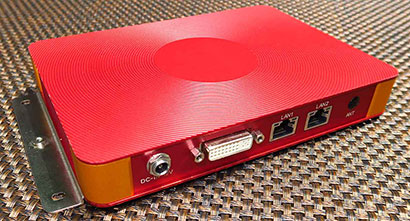
The footprint of the ARES-1230 Series is just 7.1 x 5.1 inches, 14% smaller than an iPad mini. The base ARES-1230 is an inch tall, the 1230-E 1.6 inches. Despite all-metal construction, both weigh less than two pounds.
The image below shows an ARES-1230-E placed on top of the base ARES-1230 version.
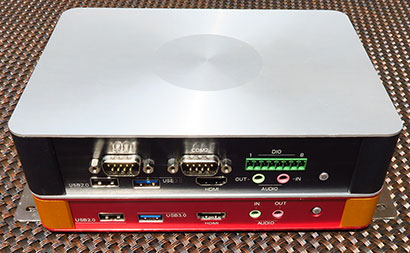
Now what's the difference between the two models? The slightly taller extended I/O ARES-1230-E version adds two additional USB 2.0 ports, two RS-232/422/485 serial ports, and four DI/DO ports for additional peripheral connectivity. Both versions include dual mPCIe slots to accommodate WiFi, Bluetooth, GPS or other modules to provide wireless connectivity for communication, positioning and navigation deployments. The 1230-E, however, has a SATA port for accommodating a standard 2.5-inch drive.
ARES-1231: When yet more I/O is needed
There may be situations where the two additional USB 2.0 ports, two additional RS232 serial ports, and four DI/DO ports of the ARES 1230-E still aren't enough. Then it may be time to roll out the big guns, in this case the ARES-1231.
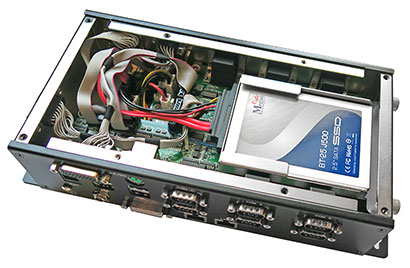
What the ARES-1231 brings to the table is a full 16 COM ports, and a full set of 16 DI and 16 DO ports. Of the COM ports, they all use standard DB9 connectors, but they come in three different configurations. Eight can be set to be either RS-232 or RS-485, four are DIM switch selectable for RS-232/422/485, and four are PIN-header selectable between RS-232 and RS-485. The digital IO ports use two DB26 connectors with 8DI and 8DO each.
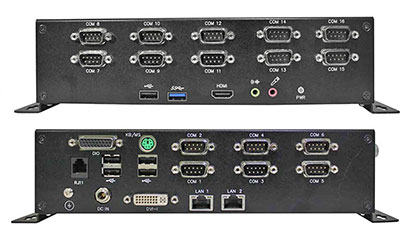
Note that the ARES-1231 also has an RJ11 port, a rarity these days. Here it's used for cash drawer communication.
|
ARBOR
|
ARES-1230
|
ARES-1230-E
|
ARES-1231
|
|
CPU
|
Celeron N2930
|
Celeron N2930
|
Celeron N2930
|
|
Cores/Threads
|
4/4
|
4/4
|
4/4
|
|
Clock Speed
|
1.83/2.16 GHz
|
1.83/2.16 GHz
|
1.83/2.16 GHz
|
|
Size (mm)
|
180 x 130 x 25
|
180 x 130 x 40
|
240 x 127 x 60
|
|
Video
|
1 x DVI, 1 x HDMI
|
1 x DVI, 1 x HDMI
|
1 x DVI, 1 x HDMI
|
|
LAN
|
2 x Gbe RJ45
|
2 x Gbe RJ45
|
2 x Gbe RJ45
|
|
RJ11
|
none
|
none
|
1 x RJ11
|
|
USB 2.0
|
1 x USB 2.0
|
3 x USB 2.0
|
5 x USB 2.0
|
|
USB 3.0
|
1 x USB 3.0
|
1 x USB 3.0
|
1 x USB 3.0
|
|
Digital I/O
|
None
|
4 x DI, 4 x DO
|
16 x DI, 16 x DO
|
|
Serial
|
None
|
2 x RS-232/422/485
|
16 x RS-232/422/485
|
|
SATA for 2.5"
|
no
|
yes
|
yes
|
|
Power
|
12V DC
|
9 ~ 36V DC
|
12V DC
|
The table above shows what's the same and what is different between the three members of the ARES-123x Series.
Design and construction
In terms of construction, the ARES-1230 Series consists of beautifully milled aluminum top and bottom, spaced apart by aluminum corner pieces or sides. Finned aluminum heat dissipators are added on the two small sides of the rectangular body which acts as the primary heat sink, eliminating the need of a fan. Our sample 1230 model came in colorful anodized red and orange, the enhanced 1230-E model in more discrete silver and black.
Below is a look inside each of the controllers, the 1230 on top and the 1230-E on the bottom. Opening the units is very simple. Undo four small screws and lift off the top.
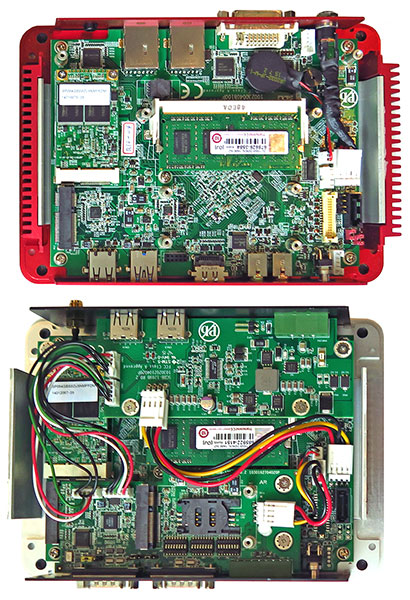
The ARES-1230 Series has a 150 x 115 mm rectangular motherboard that looks much like one of the many miniaturized ATX and ITX standard boards with edge-mounted I/O facing front and back. There's a single RAM slot, three PCI-e connectors (one mini, one half mini, and one long enough for up to 115mm modules).
The basic ARES-1230 comes with that motherboard that includes RAM, an SSD (in our eval a 64GB mSATA-I50 module from Silicon Power), HDMI, DVI-I, audio in and out, one each of USB 2.0 and 3.0, a couple of RJ45 LAN ports, a cutout for an external antenna pass-through, and the power jack. That makes the ARES-1230 a perfectly functional super-compact computer for numerous applications. But what if the ARES-1230 form factor is perfect for the job, but those ports just aren't quite enough?
That's where the genius of this design comes into play. The ARES-1230 board is designed to accommodate extra board layers for additional functionality via stacked modules and daughterboards. The addition of such boards makes the ARES-1230-E.
Specifically, there's a large module that uses the long mini PCI-e connector on the motherboard to add two COM ports, digital I/O, a SIM card slot, and its own mini PCI-e connector. This module then daisy-chains to a second board that adds to additional USB ports and also replaces the base ARES 1230's power jack with an industrial 3-pin block connector with a wide input power range. All of this adds just 15mm of height, 5/8th of an inch. The footprint stays the same. Note, though, that the 1230-E motherboard i slightly modified, so it's not just a matter of adding the two extra boards to get a base ARES 1230 to 1230-E status.
Intel Bay Trail powered
For processing power, all versions of this ARBOR ARES controller trio use the same quad-core Intel Celeron N2930, a system-on-chip solution that runs at 1.83GHz, has a burst frequency of 2.16GHz,  supports fast but efficient DDR3L RAM, and yet still has a Thermal Design Power of just 7.5 watts. Both of our test units came with 2GB of DDR3L RAM and a speedy 64GB mSATA SSD module from Silicon Power.
supports fast but efficient DDR3L RAM, and yet still has a Thermal Design Power of just 7.5 watts. Both of our test units came with 2GB of DDR3L RAM and a speedy 64GB mSATA SSD module from Silicon Power.
The Celeron N2930 CPU is part of Intel's next-gen "Bay Trail" platform which employs 22nm process technology and has integrated graphics cores of the same HD 4000 architecture and variety as those used in Intel's 3rd generation "Ivy Bridge" processors, albeit with fewer execution units (four instead of several times that number) and lower clock speeds. The N2930 is also the same chip ARBOR used in its Gladius G0975 rugged tablet (see our review of the G0975).
To see how the quad-core N2930 fares in the ARES-1230, ARES-1230-E, and ARES-1231, we used Passmark Software's PerformanceTest 6.1 that runs about 30 tests covering CPU, 2D graphics, 3D graphics, memory, and disk and then computes scores for each category and an overall PassMark score. We also ran our secondary standard benchmark suit, CrystalMark:
|
Performance benchmarks
|
ARES 1230
|
ARES 1230-E
|
ARES 1231
|
|
CPU Mark
|
1,548.9
|
1,544.4
|
2,195.1
|
|
2D Graphics Mark
|
166.4
|
168.5
|
198.4
|
|
Memory Mark
|
387.5
|
388.0
|
466.7
|
|
Disk Mark
|
1,563.1
|
1,441.1
|
553.6
|
|
3D Graphics Mark
|
137.0
|
137.2
|
142.4
|
|
Overall PassMark
|
840.3
|
815.1
|
832.2
|
|
CrystalMark ALU
|
29,218
|
29,124
|
28,904
|
|
CrystalMark FPU
|
24,591
|
24,685
|
24,500
|
|
CrystalMark MEM
|
20,745
|
20,255
|
21,048
|
|
CrystalMark HDD
|
32,772
|
30,432
|
13,214
|
|
CrystalMark GDI
|
4,404
|
4,407
|
5,999
|
|
CrystalMark D2D
|
3,967
|
3,967
|
4,010
|
|
CrystalMark OGL
|
3,613
|
3,707
|
3,873
|
|
Overall CrystalMark
|
119,300
|
116,574
|
101,548
|
We didn't include any comparison units, but we still found some facts worth mentioning:
- First, the performance level achievable with this relatively simple Bay Trail processor is at the level of much higher-end first generation Core processors of just a few years ago. That's remarkable.
- Second, our test units ran the 32-bit version of Windows 7. For some reason, the CPU benchmark numbers Passmark reported for the 1230 and 1230-E were about 25% lower than we saw with the same N2930 processor in the ARES-1231 (and also in the ARBOR Gladius G0975) with the same chip, but running 64-bit Windows. CrystalMark benchmarks did not deviate, so it may a benchmark issue, but we wanted to mention it because it also may be a multi-processor performance difference between the 32 and 64-bit versions of Windows 7.
- Third, the only performance difference between the 1230 and the 1230-E we noticed was the slightly lower disk numbers of the 1230-E. The SSDs were the same, and both had a SATA/600 interface, so the extra component overhead of the 1230-E may account for the difference. The 1231, on the other hand, used a 2.5-inch SATA/300 SSD, that benchmarked considerably lower. So if performance is an issue, keep an eye on the OS used, as well as on the type of SSD.
Significant application potential
ARBOR's ARES-1230 Series is well equipped for a large variety of tasks. While ARBOR mentions digital signage, machine automation and the retail sector as the primary intended applications, the opportunities for the platform are endless. ARBOR says that ARES-1230/31 Series controllers are already in use in gas station POS applications as well as in a train station gate ticketing project.
The base ARES-1230 model with dual LAN and HDMI as well as DVI video can easily mounted onto the back of a display panel. The extended ARES-1230-E version adds legacy serial communications functionality, flexible input power, and additional USB ports, while adding just a fraction of an inch in height.
Although based on the same processor technology and using many of the same components, the ARES-1231 is a different animal, one designed to allow a single controller handle a large number of attached devices.
All this combines to make the ARBOR ARES-123x Series an exceptionally flexible and highly configurable fanless embedded controller platform that minimizes turnkey solution development cost, time, and effort.
|



